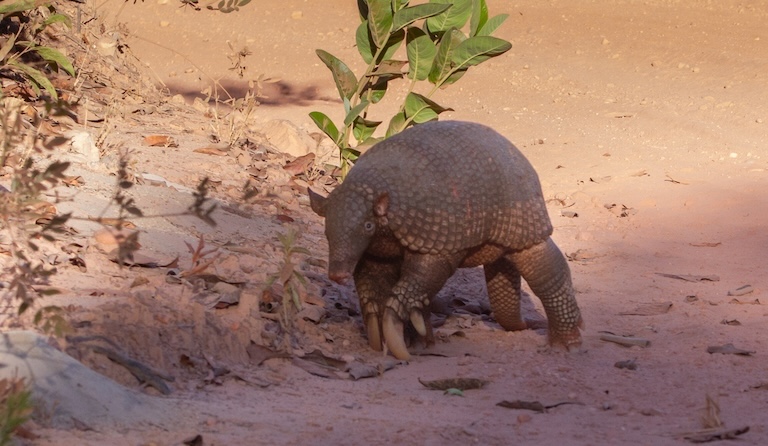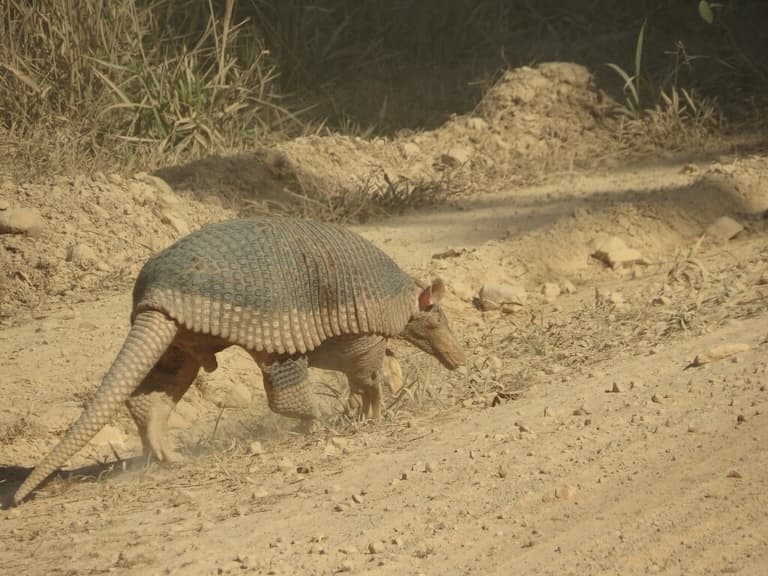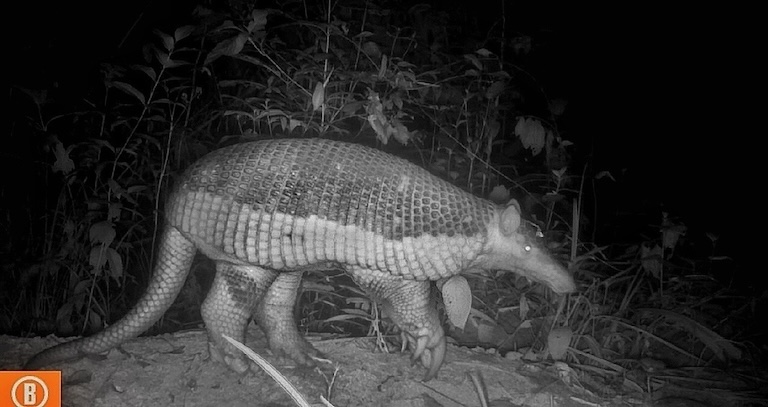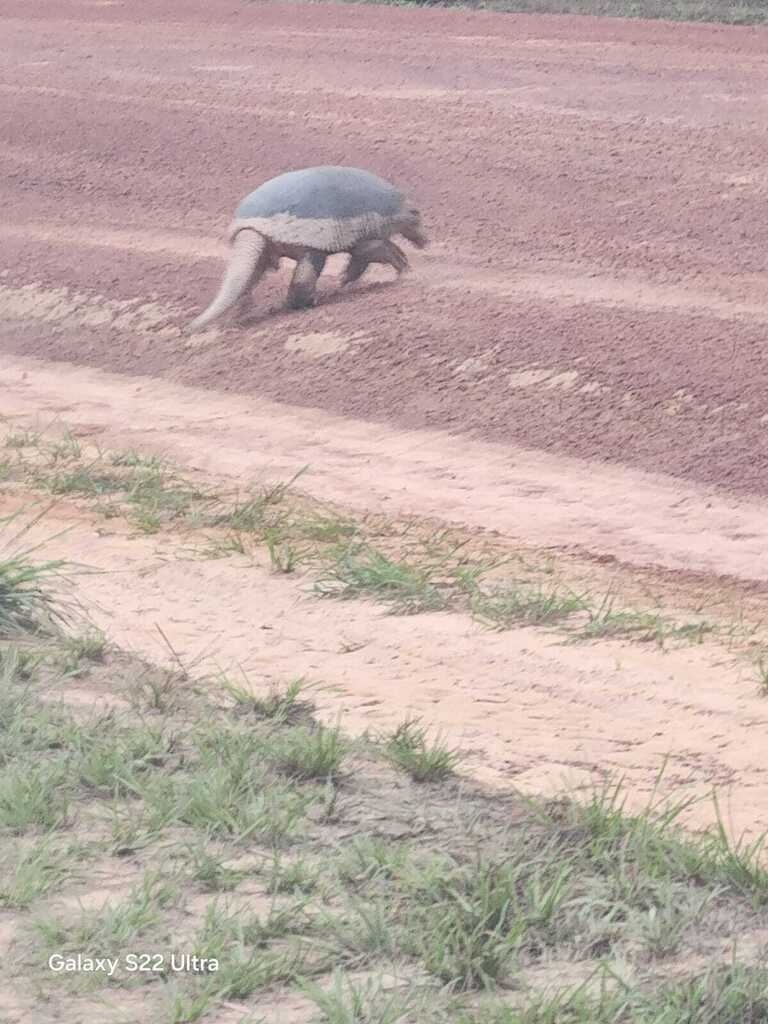Giant Armadillo Profile
South American megafauna is woefully under-represented in pop culture.
Before the continent bumped into the land of sabre-toothed cats and mammoths, it was home to giant, terrestrial birds, colossal sloths and 2-tonne armadillos built like tanks.
Unfortunately, the birds don’t exist anymore and the sloths are a lot smaller now, but there’s one species of armadillo that hangs onto gigantism by a thread.
A far cry from its ancestors, but still an impressive bulk of armoured mammal at up to 80 kg, the giant armadillo goes a lot farther in representing the old days than such cousins as the pink fairy armadillo that looks more like a pork scratching with legs.

Giant Armadillo Facts Overview
| Habitat: | Open habitats, grasslands, lowland forests |
| Location: | Northern South America |
| Lifespan: | Unknown |
| Size: | 75–100 cm (30–39 in), with a 50 cm (20 in) tail |
| Weight: | Usually up to 32.5 kg (72 lb), extreme cases 54 kg to 80 kg (119 lb to 180 lb) |
| Colour: | Dark brown to black |
| Diet: | Termites and ants; also worms, grubs, bees, spiders, snakes and plants |
| Predators: | Humans |
| Top Speed: | Slow |
| No. of Species: | 1 |
| Conservation Status: | Vulnerable (IUCN) |
The giant armadillo is the largest remaining of the ancient order of Cingulata. It holds the torch as an original South American armoured anteater and differs from other armadillos not only in its size but also in its relatively broad diet.
Despite being the biggest of the lot, it’s probably the least well-understood and being solitary and camouflaged with large home ranges, the population densities of this species are naturally low.
Still, human hunters are able to make a dent in its numbers and this inherently rare animal is becoming even less common.
Interesting Giant Armadillo Facts
1. They’re cousins of the Glyptodonts
South America is home to some of the most epic mammalian fauna left from the Pleistocene. Many of these mammals are in the superorder Xenarthra, which contains the sloths, anteaters and armadillos, all of whom had a more giant recent relative that unfortunately didn’t make it to the family dinner this year.
For the armadillos, this monstrous relative was the glyptodont family: tank-like armadillos that weighed over 2 tonnes and stood around 1.5 metres tall. Some had Ankylosaur-esque spiked clubs on the end of their tails to fend off the truly heinous predators of the times.
They, along with countless other iconic giants, went abruptly extinct almost immediately after the first humans arrived in the Americas. Despite the changing climate at this time, there is a coincidence here that should send up some flags.
What remains are their smaller, less-tasty relatives, and of the armadillo groups – four of which have only just been distinguished in June ’24 – the giant armadillo is the largest remaining. They share their family with the three-banded and naked-tailed armadillos.
While most of the smaller armadillos have tiny mouths and a handful of rudimentary “tooth-pegs” like an old pirate, this brute has a mouth packed with chompers.

2. They have teeth
Most humans have 32 teeth in adulthood, give or take. Chimps have the same; hippos have about 36 (with eight that really matter), sloths have 18-ish and many anteaters have the nice round number of zero.
Most armadillos feature a sprinkling of small, peg-like molars with exposed roots and no enamel. This is somehow fine with them, as they mostly suck up ants and can barely open their mouths at all.
But the giant armadillo has the most teeth of any other mammal, with up to 100 gnashers including premolars and molars, though greatly reduced.
These teeth also have no enamel and grow continuously throughout the animal’s life.
This arrangement reflects the giant armadillo’s adaptable feeding habits, and while it will always pick ants and termites if they’re on the menu, it isn’t too upset when worms, grubs and bees are in season. It’s even said to eat larger animals like snakes, as well as some carrion and even plant matter on occasion.
But along with record-breaking teeth, come record-breaking claws. 1
3. They have claws
This incredible mammal is a known digger. The giant armadillo digs burrows to live in, digs into the side of termite mounds, and even digs its way into a colony of bees sometimes when it has a hankering for spicy food.
Its front claws are well worthy of an ominous Dr. Grant monologue, at up to 22 cm long, sickle-shaped and perfect for scaring children.
These are the largest claws, proportionally, to any living mammal. And this is a very strong animal; while you wouldn’t want it clawing at you in self-defence, it’s more likely to use them to dig an escape tunnel when threatened.
These excavations create new ecosystems and structure habitats for at least 24 species of vertebrates in Brazil, at least in the specific region studied, though this animal is so poorly known, it’s likely to be far more significant than that. 2
4. Nobody’s ever seen their babies in the wild
To put it into perspective, this species has gone the way of the pigeon and successfully hidden its offspring from human eyes for eternity.
The life history of giant armadillos has been inferred almost exclusively from a handful of captive specimens. 3

5. They’re naturally rare
Wild research has defined their home ranges as around 10 km2, with a minimum density of just over 3 individuals per 100 km2, making it significantly scanter than, say humans, whose equivalent average population density is around two thousand times as high.
To top it off, they’re nocturnal, camouflaged, and spend time hiding underground, so are naturally hard to spot. And being solitary animals, they just exude “leave me alone” energy.
This naturally low-density life is quite fine as long as humans respect that energy. Sadly, as we all know, they don’t. 4
6. They’re getting rarer
It wouldn’t be so bad if it was only researchers interfering with these elusive animals, but unfortunately, they’re hunted at a rate that appears to be unsustainable.
These animals are thought to take around 4 months to gestate and give birth to a single offspring, so replenishing populations can be a slow process.
Currently, the true generation length is still not known, and the lack of data makes conservation very difficult to figure out, but it’s thought that the populations are declining and are not stable.
Deforestation removes habitat and at the same time increases access from human hunters to the armadillos, and there’s an as-yet unquantified effect of illegal animal collecting happening for wealthy jerks to keep exotic animals.

Giant Armadillo Fact-File Summary
Scientific Classification
| Kingdom: | Animalia |
| Phylum: | Chordata |
| Class: | Mammalia |
| Order: | Cingulata |
| Family: | Tolypeutinae |
| Genus: | Priodontes |
| Species: | maximus |
Fact Sources & References
- Tracy S. Carter (2016), “Priodontes maximus (Cingulata: Chlamyphoridae)”, Oxford Academic.
- Arnaud Léonard Jean Desbiez (2013), “The Role of Giant Armadillos (Priodontes maximus) as Physical Ecosystem Engineers”, Wiley Online Library.
- Leandro Silveira (2009), “Ecology of the Giant Armadillo (Priodontes maximus) in the Grasslands of Central Brazil”, Bio One Digital Library.
- A L J Desbiez (2019), “Spatial ecology of the giant armadillo Priodontes maximus in Midwestern Brazil”, Oxford Academic.
